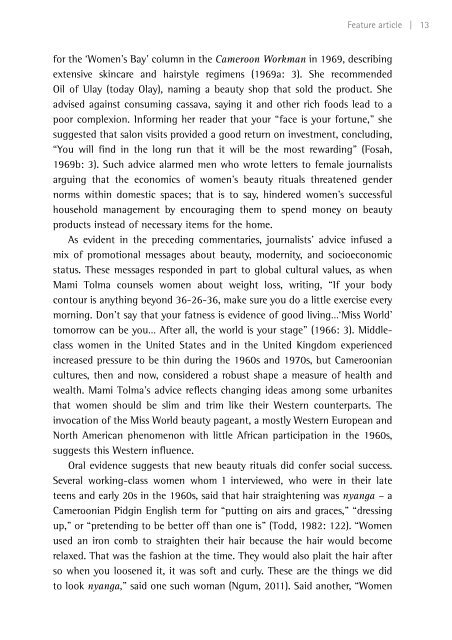The politics of fashion and beauty in Africa
fa21_proof_3
fa21_proof_3
You also want an ePaper? Increase the reach of your titles
YUMPU automatically turns print PDFs into web optimized ePapers that Google loves.
Feature article | 13<br />
for the ‘Women’s Bay’ column <strong>in</strong> the Cameroon Workman <strong>in</strong> 1969, describ<strong>in</strong>g<br />
extensive sk<strong>in</strong>care <strong>and</strong> hairstyle regimens (1969a: 3). She recommended<br />
Oil <strong>of</strong> Ulay (today Olay), nam<strong>in</strong>g a <strong>beauty</strong> shop that sold the product. She<br />
advised aga<strong>in</strong>st consum<strong>in</strong>g cassava, say<strong>in</strong>g it <strong>and</strong> other rich foods lead to a<br />
poor complexion. Inform<strong>in</strong>g her reader that your “face is your fortune,” she<br />
suggested that salon visits provided a good return on <strong>in</strong>vestment, conclud<strong>in</strong>g,<br />
“You will f<strong>in</strong>d <strong>in</strong> the long run that it will be the most reward<strong>in</strong>g” (Fosah,<br />
1969b: 3). Such advice alarmed men who wrote letters to female journalists<br />
argu<strong>in</strong>g that the economics <strong>of</strong> women’s <strong>beauty</strong> rituals threatened gender<br />
norms with<strong>in</strong> domestic spaces; that is to say, h<strong>in</strong>dered women’s successful<br />
household management by encourag<strong>in</strong>g them to spend money on <strong>beauty</strong><br />
products <strong>in</strong>stead <strong>of</strong> necessary items for the home.<br />
As evident <strong>in</strong> the preced<strong>in</strong>g commentaries, journalists’ advice <strong>in</strong>fused a<br />
mix <strong>of</strong> promotional messages about <strong>beauty</strong>, modernity, <strong>and</strong> socioeconomic<br />
status. <strong>The</strong>se messages responded <strong>in</strong> part to global cultural values, as when<br />
Mami Tolma counsels women about weight loss, writ<strong>in</strong>g, “If your body<br />
contour is anyth<strong>in</strong>g beyond 36-26-36, make sure you do a little exercise every<br />
morn<strong>in</strong>g. Don’t say that your fatness is evidence <strong>of</strong> good liv<strong>in</strong>g…‘Miss World’<br />
tomorrow can be you… After all, the world is your stage” (1966: 3). Middleclass<br />
women <strong>in</strong> the United States <strong>and</strong> <strong>in</strong> the United K<strong>in</strong>gdom experienced<br />
<strong>in</strong>creased pressure to be th<strong>in</strong> dur<strong>in</strong>g the 1960s <strong>and</strong> 1970s, but Cameroonian<br />
cultures, then <strong>and</strong> now, considered a robust shape a measure <strong>of</strong> health <strong>and</strong><br />
wealth. Mami Tolma’s advice reflects chang<strong>in</strong>g ideas among some urbanites<br />
that women should be slim <strong>and</strong> trim like their Western counterparts. <strong>The</strong><br />
<strong>in</strong>vocation <strong>of</strong> the Miss World <strong>beauty</strong> pageant, a mostly Western European <strong>and</strong><br />
North American phenomenon with little <strong>Africa</strong>n participation <strong>in</strong> the 1960s,<br />
suggests this Western <strong>in</strong>fluence.<br />
Oral evidence suggests that new <strong>beauty</strong> rituals did confer social success.<br />
Several work<strong>in</strong>g-class women whom I <strong>in</strong>terviewed, who were <strong>in</strong> their late<br />
teens <strong>and</strong> early 20s <strong>in</strong> the 1960s, said that hair straighten<strong>in</strong>g was nyanga – a<br />
Cameroonian Pidg<strong>in</strong> English term for “putt<strong>in</strong>g on airs <strong>and</strong> graces,” “dress<strong>in</strong>g<br />
up,” or “pretend<strong>in</strong>g to be better <strong>of</strong>f than one is” (Todd, 1982: 122). “Women<br />
used an iron comb to straighten their hair because the hair would become<br />
relaxed. That was the <strong>fashion</strong> at the time. <strong>The</strong>y would also plait the hair after<br />
so when you loosened it, it was s<strong>of</strong>t <strong>and</strong> curly. <strong>The</strong>se are the th<strong>in</strong>gs we did<br />
to look nyanga,” said one such woman (Ngum, 2011). Said another, “Women



